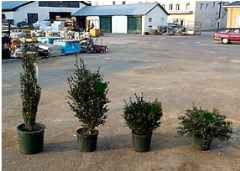 Left
to Right "SKYPENCIL", "NIGRA", "COMPACTUM", & "HELLERI". Left
to Right "SKYPENCIL", "NIGRA", "COMPACTUM", & "HELLERI". |
|
|
 Left
to Right "SKYPENCIL", "NIGRA", "COMPACTUM", & "HELLERI". Left
to Right "SKYPENCIL", "NIGRA", "COMPACTUM", & "HELLERI". |
|
|
Ilex is the genus name for "holly". There are many species of holly and 100's of varieties of holly. The genus species Ilex crenata represents a group of hollies known as the "Japanese Holly". Japanese hollies are evergreen foundation plants which provide a constant green background. The flowers and berries of the Japanese hollies are neither significant or colorful - it's a green bush! This constant green provides a foundation for other plants such as flowering perennials with a limited bloom period and seasonal foliage. The importance of an evergreen base is to provide some form of plant life in the dismal months of winter. Evergreens also give a contrasting backdrop during the colorful growing season.
Japanese hollies come in all sizes and shapes to accommodate a variety of landscaping needs. Choices include the low mounding Helleri, the round "boxwood like" Compactum, the columnar "Skypencil", and the conical shaped "Hetzi" to name a few. Japanese hollies are a typical acid loving plant preferring a pH of 5.0 to 6.0 as well as good drainage. They are sun lovers with only a mild tolerance to shade. Direct competition with roots of large trees renders a sparsely foliated plant struggling to survive. Good drainage is important but they do need sufficient, even moisture for proper growth and survival. Overall the Japanese hollies are easy to grow.
The low mounding Ilex crenata "Helleri" (Genus, species, "Variety") is very functional as an edging plant as well as an evergreen needing a low profile. "Helleri" is slow growing with a maturity of 2 feet tall and 3 to 6 feet in diameter. The slow growth rate means they have a compact root system, so they must be monitored in drought periods to prevent dehydration of the root system which often results in death. (Helleri is an easy to grow plant - I just like to remind people that compact plants tend to have compact root systems).
Ilex crenata "Soft Touch" is a newer variety of a low mounding Japanese holly featuring softer foliage and a more compact growth habit with a height and width of 2 feet. The rate of growth is even slower than Cousin Helleri. This plant promises to be very popular.
Ilex crenata "Skypencil" is also a newer variety with a very, tight columnar growth habit reaching a height of 10 to 12 feet and a diameter of 2 to 3 feet. "Skypencil" has a fairly rapid growth rate. This plant is popular for punctuating corners or framing entryways.
Ilex crenata "Compactum" is a long standing favorite as a foundation plant. "Compactum" has a moderate growth rate with a maturity of 4 feet in diameter. The moderate growth rate allows for infrequent pruning. "Compactum" has been used as a boxwood substitute because it is less expensive and faster growing, which comes in handy when replacements are required. The telltale sign of the difference is that Japanese hollies have a slight serration on the leaf margin whereas boxwoods have a smooth leaf edge. The trained eye can distinguish between the two ease from some distance. Boxwood are often equated with formality, so "Compactums" are not for everyone. However, they are "easy keepers" and often work well in the landscape.
Additional Ilex crenata include "Rotundifolia" which grows rapidly to a massive 8 feet high and 6 feet wide maturity. "Steeds" and "Nigra" grow in a conical or "pyramidal" at a fairly rapid growth rate reaching a height of 6 feet at maturity. "Steeds" is more narrow with a mature diameter of 3 feet. "Nigra" has a mature diameter of 4 feet and a darker foliage. Have a Happy Hollyween!
Andy Lynn